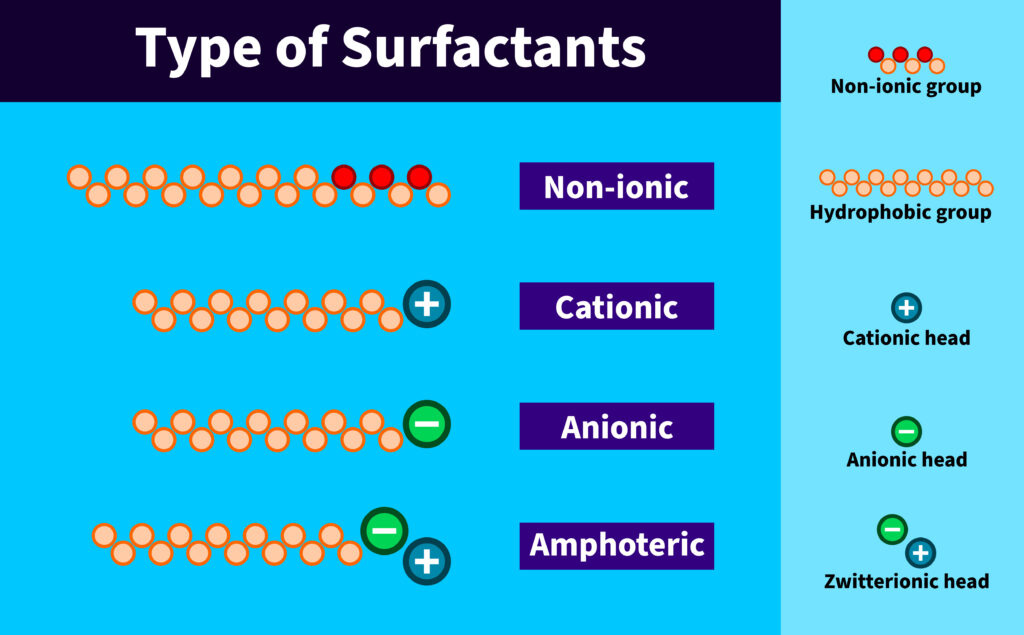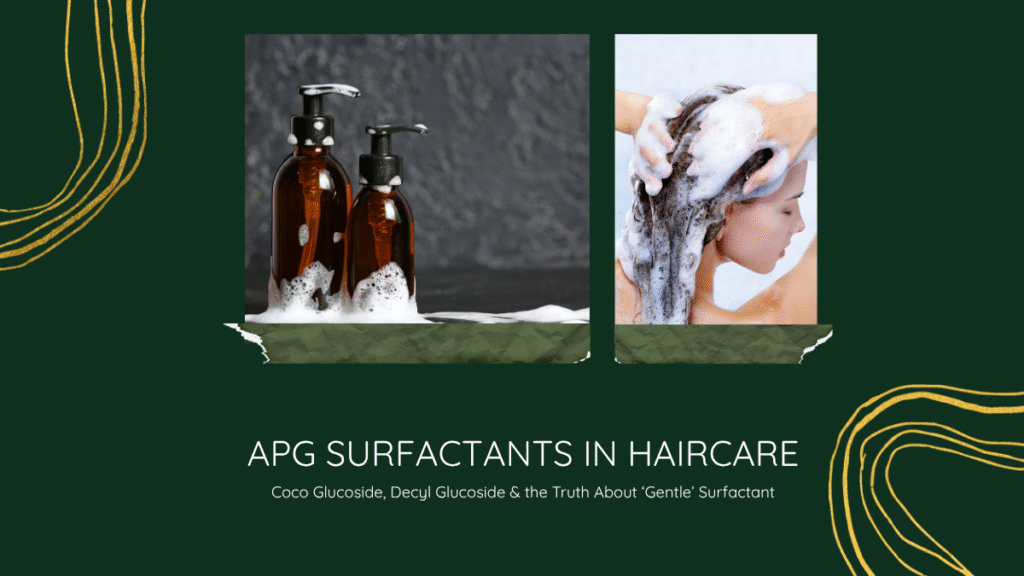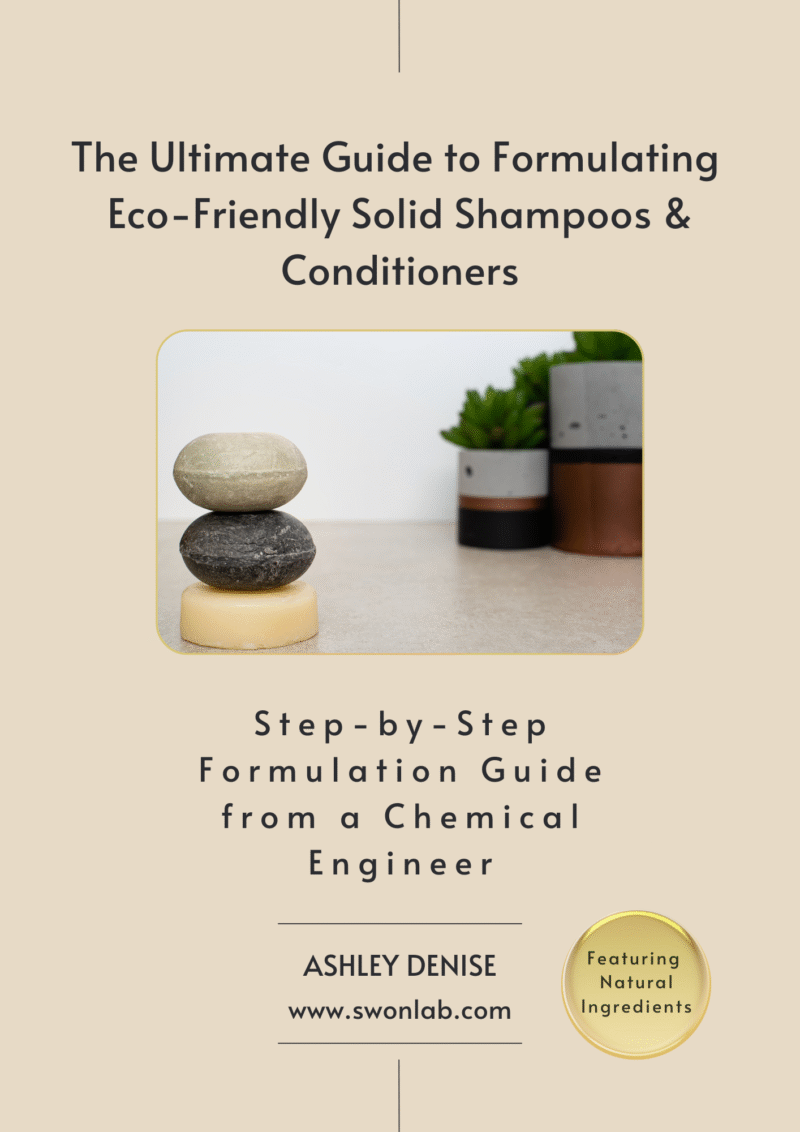Alkyl Polyglucosides (APGs) like Coco Glucoside and Decyl Glucoside are often marketed as “gentle” and “natural” surfactants—but do they really live up to the hype? If you’re formulating shampoos or exploring solid bars, understanding how APGs function, where they shine, and where they fall short is key to creating products that perform. In this post, we break down the science behind these non-ionic surfactants, when to use them, and how to make them work—even in formats they’re not usually suited for.
Table of Contents
What Are Alkyl Polyglucosides (APGs)?
Alkyl Polyglucosides (APGs) are a class of non-ionic surfactants derived from renewable, plant-based sources—typically sugars (like glucose) and fatty alcohols (from coconut or palm). This combination gives them a unique dual nature: they’re both mild and effective cleansers, making them ideal for sensitive skin and hair care products.
But what exactly makes them “natural”?
APGs are made through a process called acid-catalyzed condensation, where glucose (usually from corn starch) is reacted with fatty alcohols. While the raw materials are natural, the resulting ingredient is semi-synthetic—not 100% untouched, but widely considered biocompatible and eco-friendly.
How Non-Ionic Surfactants Like APGs Work

Unlike anionic or cationic surfactants, non-ionic surfactants have no electrical charge. This makes them extremely mild, pH-flexible, and skin-friendly—ideal for sensitive formulations.
Alkyl Polyglucosides (like Coco or Decyl Glucoside) have:
- Hydrophilic head made of glucose
- Lipophilic tail made of fatty alcohols
This structure allows them to gently remove dirt and oil without damaging the scalp barrier. They also blend well with other surfactants (like amphoterics), making them versatile in both shampoo and facial cleanser formulas.
Common Questions About APGs:
Are alkyl polyglucosides natural or synthetic?
APGs are semi-synthetic surfactants made by combining plant-derived glucose with fatty alcohols. They’re not 100% natural, but widely accepted as safe and eco-friendly.
Are APGs safe for sensitive skin?
Yes. Their non-ionic structure makes them among the mildest surfactants available, with very low irritation potential.
Are alkyl polyglucosides biodegradable?
Absolutely. APGs degrade quickly and are considered environmentally safe. Many meet EU Ecolabel and OECD biodegradability standards.
Do APGs foam well?
Not as much as sulfates, but they provide a gentle, creamy lather—especially when combined with other surfactants like CAPB.
Popular Types of APGs in Haircare
Coco Glucoside, Decyl Glucoside & Lauryl Glucoside – What’s the Difference?
Alkyl Polyglucosides (APGs) may share a similar backbone—glucose + fatty alcohol—but their functionality in haircare varies depending on the chain length of the alcohol used. Here’s how the most commonly used ones compare in real-life formulations:
Coco Glucoside
- Fatty Alcohol Source: C8–C14 (mainly coconut-derived)
- Foaming: Moderate; soft, stable foam
- Viscosity: Thick, around 2500 mPa.s (very viscous)
- Typical Usage: 2–30%
- pH Range: Very alkaline (11.5–12.5) → must be adjusted
- Best for: All-around surfactant — works well as both primary and secondary
💡Notes:
It’s gentle and easy to work with, but the high pH makes it a bit tricky for beginner formulators. Adjust with citric acid to bring it down to pH 4.5–5.5 for hair and scalp compatibility.
Decyl Glucoside
- Fatty Alcohol Source: Mainly C10, sometimes with C8–C14
- Foaming: High flash foam; fast and fluffy but not dense
- Viscosity: Medium
- Typical Usage: 4–40%
- pH Range: 7–11.5
- Best for: Gentle shampoos, baby products
💡Notes:
Often considered the most “balanced” of the APGs. It foams well, is very mild, and rinses cleanly. However, it won’t work miracles alone—you’ll likely want to combine it with an amphoteric surfactant for foam richness.
Lauryl Glucoside
- Fatty Alcohol Source: C12 (lauryl alcohol)
- Foaming: Moderate; stable but slower to develop
- Viscosity: Very thick (can even come in a jar!)
- Typical Usage: 2–35%
- pH Range: Can reach up to 12 → pH adjustment required
- Best for: Viscosity building, foam stabilization
💡Notes:
Not very bubbly on its own, but shines in combination with anionic surfactants. Great for formulating more conditioner-like shampoo textures. Perfect for sensitive scalp blends when foam control is important.
Coco vs Decyl vs Lauryl – At a Glance
| Property | Coco Glucoside | Decyl Glucoside | Lauryl Glucoside |
| Chain Length | C8–C14 (mixed) | Mostly C10 | C12 |
| Viscosity | High | Medium | Very High |
| Foam | Soft, stable | Fast, light | Slow, stable |
| Usage Range | 2–30% | 4–40% | 2–35% |
| Primary Use | Balanced choice | Mild cleansers | Thickening agent |
| pH (as-is) | ~12 | ~10 | ~12 |
❗Important Formulation Tip:
- All three glucosides come with high alkaline pH—which is great for raw material stability, but not for skin or scalp.
- Always check and adjust final pH to 4.5–5.5 in haircare to maintain barrier integrity.
Why APGs Are Popular in Natural Haircare Products
Mildness, Biodegradability & Compatibility Without the Trade-Offs
Alkyl Polyglucosides (APGs) have become a go-to choice for formulators aiming to balance performance with gentleness, especially in natural or sensitive-skin-oriented haircare.
But their popularity isn’t just because they sound plant-based — it’s because they actually solve formulation problems that many traditional surfactants create.
1. Exceptionally Mild – Even at Higher Concentrations
APGs are among the least irritating surfactants available. Their non-ionic nature means they don’t disrupt the skin’s acid mantle as much as anionic surfactants (like SLS or SLES). In fact:
- They show low dermal and ocular irritation in patch tests
- Ideal for baby shampoos, sensitive scalp products, and daily-use formulas
- Can be used at relatively high active matter (up to 40%) without harshness
📌 Why it matters: You can build effective cleansing systems with APGs without compromising barrier integrity or comfort — a must for scalp health and color-treated hair.
2. Readily Biodegradable – Formulator & Consumer Friendly
Environmental impact is a huge concern in today’s formulation landscape — and APGs check all the boxes:
- Derived from renewable resources: glucose + fatty alcohols
- Pass OECD ready biodegradability tests
- Safe for aquatic environments, greywater-compatible
📌 They degrade quickly and completely, which makes them compliant with global eco-labeling standards and suitable for “green” marketing claims (without greenwashing).
3. Compatibility with Other Surfactants = Formulation Flexibility
APGs play well with others. They blend easily with:
- Amphoterics like Cocamidopropyl Betaine → boosts foam & mildness
- Anionics like Sodium Cocoyl Isethionate → enhances cleansing
- Cationics (rare in rinse-offs, but relevant in hybrid systems)
They can even stabilize emulsions, reduce irritation from harsher surfactants, and improve foam quality in hard water conditions.
✅ TL;DR – Why Formulators Love APGs
- Gentle enough for daily use
- Suitable for sensitive and allergy-prone skin
- Environmentally safe and biodegradable
- Flexible in formulas and surfactant blends
- While most APGs like Coco, Decyl, and Lauryl Glucoside are best suited for rinse-off products due to their alkaline nature and surfactant residue, Caprylyl/Capryl Glucoside stands out as a solubilizing APG that’s gentle enough for leave-on formulations like micellar waters and facial cleansers.
The Formulation Challenge: Using APGs in Solid Shampoo Bars
Why It’s Hard — and How to Formulate with Confidence
Alkyl Polyglucosides (APGs) like Coco Glucoside or Decyl Glucoside offer excellent mildness and environmental safety—but incorporating them into solid shampoo bars comes with unique technical challenges.
1. They’re Liquid & High-Water Activity Ingredients
Most APGs are liquid at room temperature, with roughly 50% water content. This increases the overall moisture load in your formula and can interfere with solid bar structure—especially when not properly balanced with hardening agents and powders.
📌 Result: If not carefully formulated, your bar may become too soft, sticky, or fail to cure properly.
2. Structural Balance Must Be Carefully Engineered
Unlike traditional salt-thickened liquid systems, solid shampoos rely on a careful ratio of powder surfactants (e.g., SCI), waxes, butters, and fatty alcohols to achieve a firm texture. Adding liquid surfactants like APGs affects that structure.
📌 Formulation Insight: APGs can dilute the bar matrix and soften it—so ingredients like rice bran wax, cetyl alcohol, or BTMS-50 should be adjusted accordingly to reestablish structure and long-term bar stability.
3. High Alkaline pH Requires Adjustment
Coco and Decyl Glucoside typically arrive with a raw pH of 11–12. In a solid shampoo, this can:
- Interfere with acid-sensitive ingredients
- Irritate the scalp if left uncorrected
- Destabilize certain preservatives or proteins
📌 Solution: Always pH-adjust the final blend using citric acid or other buffers to target pH 4.5–5.5 for scalp health.
4. Phase Stability Depends on Solid-Liquid Balance, Not Emulsification
Solid bars aren’t emulsions. We’re not blending oil and water—we’re pressing a structured, waterless system. That said, liquid surfactants still need to be physically stabilized within the matrix.
📌 Practical Tip: Ensure that APGs are incorporated during the hot phase, then combined with structure builders like SCI, BTMS-50, fatty alcohols to prevent phase separation, sweating, or soft spots.
Strategic Formulation: Use APGs for Balanced Surfactant Systems
Rather than avoiding APGs, smart formulators use them to create a balanced surfactant profile:
- Anionic (e.g., SCI) → primary cleansing, dense foam
- Non-ionic (APG) → mildness, stability in hard water
- Amphoteric (e.g., CAPB) → foam synergy, irritation reduction
- Cationic (e.g., BTMS-50) → conditioning boost without destabilizing the bar
📌 This only works in solid format. In liquids, cationic + anionic = incompatibility.
Solid bars give us a unique opportunity to combine surfactants that normally clash.
Further Reading
Want to dive deeper into surfactants, shampoo formulation, and solid haircare products? These articles are packed with practical insights:
- Sodium Cocoyl Isethionate (SCI): Why It’s the Hero of Solid Shampoo Bars
Discover why SCI is one of the most effective and beginner-friendly surfactants for solid shampoos.- 7 Common Mistakes in DIY Shampoo Recipes (And How to Do It Right)
Avoid the most frequent pitfalls in shampoo formulation with this essential checklist.- Solid Shampoo vs Liquid Shampoo: Formulation, Shelf Life & Sustainability Compared
A full comparison of solid vs. liquid shampoos — from ingredients to environmental impact.- How to Formulate Solid Shampoo Bars: A Beginner’s Guide to Surfactants & Oils
A step-by-step starter guide to building functional, stable, and skin-safe solid shampoo bars.
✅ Usage Guidelines:
In solid shampoo formulations, APGs can be safely used at 4–10% depending on:
- Your base surfactant (SCI, SLSa, etc.)
- The hardness/stability targets of the bar
- The humectants and softeners present
Formulation Strategies: How to Make It Work
How to Successfully Use APGs in Solid Shampoo Bars
If you’re determined to include Coco Glucoside, Decyl Glucoside, or other APGs in your solid shampoo bar — good news: it’s totally doable. But it’s not a “plug-and-play” scenario. You’ll need to think strategically about surfactant balance, structure, and compatibility.
1. Start with a Solid Foundation – Literally
Your solid base should be strong enough to absorb the extra liquid phase introduced by APGs. This means:
- A high % of powder surfactants like SCI or SLSa (typically 50–65%)
- Hardening agents like cetyl alcohol, waxes, and butters
- Emulsifying thickeners like BTMS-50 for structure + conditioning
📌 Golden combo: SCI + Coco Glucoside + CAPB + BTMS-50
→ Cleansing + mildness + foam + conditioning
2. Incorporate an Amphoteric for Better Foam and Stability
APGs alone can feel thin or weak. But paired with an amphoteric surfactant like Cocamidopropyl Betaine (CAPB), you unlock:
- Foam boost (especially in hard water)
- Reduced irritation potential
- Improved viscosity and texture in your paste phase
📌 Use CAPB at 3–7%. Combine with APGs at 5–10% for optimal effect.
3. Control Water Activity and Drying Time
Since APGs introduce water into the system, you must limit humectants and adjust drying conditions to avoid sticky or soft bars. Tips:
- Keep panthenol, glycerin, sodium lactate under 3% total
- Avoid open-air curing in humid environments
- Dry in a low-humidity chamber or dehydrator if possible
📌 Use moisture-stabilizing ingredients like waxes, and avoid overloading hydrating agents.
4. Adjust pH Properly
Always test your final bar’s pH after curing.
Target range: 4.5–5.5 for scalp-friendly formulas
→ Use citric acid solution during hot phase if needed.
📌 Don’t skip this. Even a perfect surfactant system can irritate the scalp if pH is left unbalanced.
5. Think Like a Formulator — Balance Is Everything
Don’t expect APGs to do all the heavy lifting on their own. Use them not just for cleansing or foaming, but as part of a strategic mildness system.
Here’s a smart starting point:
- 60% Sodium Cocoyl Isethionate (anionic, cleansing)
- 7% Coco Glucoside (non-ionic, gentle)
- 7% Cocamidopropyl Betaine (amphoteric, foam & mildness)
- 3% BTMS-50 (cationic, conditioning + structure)
- 10–15% structure agents (rice bran wax, cetyl alcohol, butters)
📌 This structure mirrors the base I generally use — and yes, it works.
💡 Pro Tip:
For added emollience and a softer feel, try combining Coco Glucoside with a Coco Glucoside/Glyceryl Oleate blend. It can help reduce post-wash tightness and improve glide during application.
When (and When Not) to Use APGs in Your Haircare Formulations
A Quick-Guide for DIYers & Indie Brand Formulators
Alkyl Polyglucosides are mild, versatile, and eco-conscious surfactants but they’re not always the best fit for every formula. Here’s when to confidently reach for them… and when to think twice.
Use APGs When:
- You want a gentle cleansing base that’s safe for sensitive scalps or daily use
- You’re formulating a sulfate-free, pH-balanced shampoo or cleanser
- You want to reduce irritation from stronger anionic surfactants
- You need a surfactant system that’s readily biodegradable and “green claim”-friendly
- You’re creating a solid bar with a surfactant balance that includes anionic + amphoteric + non-ionic components
- You’re building a formula where cationic conditioning is needed — something that’s only possible in solid format due to surfactant compatibility issues in liquids
Skip APGs If:
- You’re formulating a high-active, ultra-foamy shampoo bar and want dense, creamy lather without additional surfactants
- You can’t control pH adjustment — APGs typically have alkaline raw pH and require acidification
- Your formula already contains high-moisture ingredients — APGs can push your water content too far, leading to soft or unstable bars
- You’re working on a leave-on product — Coco, Decyl, and Lauryl Glucoside are not recommended for leave-on use (Caprylyl/Capryl Glucoside is the exception)
Final Thoughts: Are APGs Worth It?
Absolutely — if you know what you’re doing.
APGs aren’t miracle surfactants, but they’re incredibly valuable tools when used intentionally. In solid formats, they give you the flexibility to build multi-type surfactant systems (anionic + non-ionic + amphoteric + cationic!) that simply wouldn’t work in a liquid product.
Used well, they can help you formulate:
- Scalp-friendly, irritation-free cleansers
- Environmentally responsible products
- Balanced bars that cleanse effectively without over-stripping
✨ The key? Don’t over-rely on them. Use them as part of a system, not the star of the show.
💬 Have you worked with APGs in your shampoo bars?
What worked — and what didn’t?
Share your experience in the comments below. Let’s learn from each other.
📚 And if you’re looking for a step-by-step guide to solid shampoo formulation — including pH, surfactant blends, conditioning agents, and complete pro-level formulas — check out our eBook:
Solid Shampoo & Conditioner Bar Formulation Guide – SwonLab eBook
A complete, science-based guide to formulating solid shampoo and conditioner bars. This 170+ page eBook includes cold & hot process methods, ingredient deep-dives, and professional-grade recipes using BTMS, surfactants, oils, and more. Beginner-friendly, eco-conscious, and results-driven.


